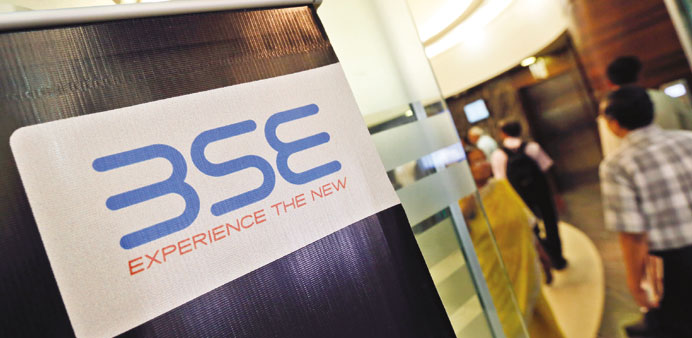The Bombay Stock Exchange logo is displayed at the entrance to the bourse’s lobby in Mumbai. The Sensex yesterday gained 0.5% to 20,811.44, the highest close since January 24.
Bloomberg/Mumbai
Indian stocks advanced, with the benchmark index climbing to a one-month high, led by capital goods producers and lenders.
Bharat Heavy Electricals rose the most in two months, sending a gauge of industrials to a seven-week high. Tata Power Co was the top performer on the benchmark S&P BSE Sensex after a regulator allowed it to raise tariffs. Axis Bank gained for a second day, pushing up an index of lenders to a one-month high. ICRA surged to a record after Moody’s Corp made an offer to boost its ownership of the credit-ratings agency.
The Sensex increased 0.5% to 20,811.44, the highest close since January 24. The measure jumped 1.6% last week after finance minister Palaniappan Chidambaram pledged to pare the fiscal deficit to a seven-year low and highlighted easing price pressures. Overseas investors bought a net $98.8mn of equities on February 21, turning net buyers this year for the first time in 16 days, data compiled by Bloomberg show.
“Economic indicators like inflation and the current-account deficit are improving,” S Naren, who oversees $13.5bn as chief investment officer at Mumbai-based ICICI Prudential Asset Management, told Bloomberg TV India. Naren said he is adding to holdings of drugmakers and software makers, the best performers on the Sensex last year.
Bharat Heavy jumped 4%, the second-best performer on the Sensex. Larsen & Toubro rallied to its highest close since December 18. The S&P BSE India Capital Goods Index rose to the highest since January 1.
Axis Bank completed its largest two-day gain in three months. ICICI Bank added 1.1%. The S&P BSE Bankex increased 1.2%.
Tata Power jumped 5.1%, the most since December 6. The company will receive Rs3.3bn ($53mn) from state-run distribution companies to make up for the higher cost of coal imported from Indonesia for the year ended March 2013, according to a regulatory order dated February 22.
The regulator also ordered utilities to charge production incentives based on actual offtake and not on their readiness to produce power at above 85% capacity use, sending NTPC, India’s largest generator, to a seven-year low. The stock slumped 12% to the lowest level since August 1, 2006.
The Sensex has retreated 1.7% this year and trades at 13.3 times projected 12-month profits, compared with the average multiple of 14.4 over the past five years. The MSCI Emerging Markets Index is valued at 10.1 times.
The CNX Nifty Index on the National Stock Exchange of India rose 0.5% to 6,186.10.
Meanwhile, India’s rupee rose to a one-week high on speculation dollar supply will increase as exporters repatriate overseas income before the March 31 financial year-end, offsetting demand for the greenback from importers.
The rupee gained 0.1% from February 21 to 62.065 per dollar in Mumbai, prices from local banks compiled by Bloomberg show. It rose as high as 61.95 earlier, the highest level since February 17. One-month implied volatility, a gauge of expected moves in the exchange rate used to price options, slid 22 basis points, or 0.22 percentage point, to 8.02%, according to data compiled by Bloomberg.

